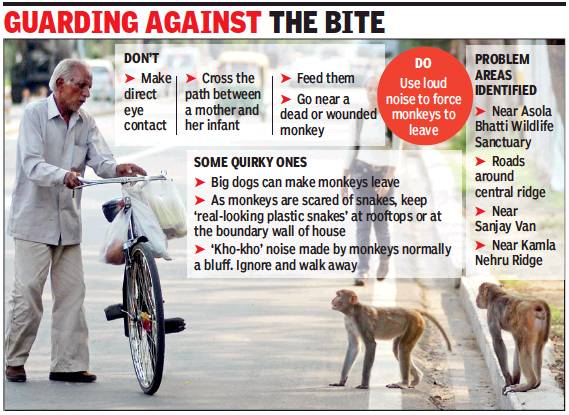Monkeys: India
This is a collection of articles archived for the excellence of their content. |
The monkey menace in urban areas
How to guard against monkeys

From: Jasjeev Gandhiok, Forest dept’s plan to keep you safe: Don’t feed or stare at monkeys, November 26, 2018: The Times of India
With the scene in Agra, where monkeys are creating havoc, even killing a 12-day old baby recently, the forest department in Delhi wants people to stop feeding the simians. Failure to comply with this order may result in legal action against violators. The department said the monkeys, especially those in areas near the Ridge, were becoming dependent on humans for food and this can reduce their ability to scavenge.
“We have observed monkeys waiting on roadsides for people to stop and give them something food,” a forest official said. “The animals are being fed fruits and cooked food, which is making them increasingly reluctant to go into the deeper forests on the Ridge to scavenge for food. If food sources are readily available, they will naturally head to the city and also become more aggressive.”
The forest and wildlife department recently held a meeting with the municipal corporations and other agencies and decided to place instruction boards at all major entrances to the Ridge. These will inform people about how to interact with monkeys so they don’t become aggressive and the legal action that can be taken against people found feeding the animals. “While we have distributed information pamphlets, permanent boards will be put up at areas considered vulnerable,” the official added.
The suggestions given in the pamphlets released by the forest department ask people not to make direct eye contact with monkeys, not to feed them, not to irritate or tease them or to go near a dead or wounded simian. The instructions also say that dustbins and overhead tanks should be kept covered in residential areas, while asking people not to hit or attack the monkey as this may provoke them.
“Keep hitting the ground with a big stick to make monkeys leave your house or garden,” the pamphlet advices. Other quirky suggestions given by the forest department include placing ‘real-looking’ plastic snakes on rooftops because monkeys try to avoid them or to keep “big” dogs because monkeys tend to be scared of their presence.
The issue of the monkey menace in the capital was raised in the Rajya Sabha earlier this year, when vice-president M. Venkaiah Naidu remarked how the animals were even causing menace at his official residence. Delhi high court too had remarked that the capital was ‘overpopulated’ with monkeys and solutions were needed to curb their growing numbers.
Delhi, 2017: the problem, and lack of solution
AlokKNMishra, Reward goes up, but few want to catch monkeys, August 26, 2017: The Times of India
The fight of the corporations against the monkey menace in the city has become one of attrition.The number of monkey-catchers has declined sharply , and even promises of handsome rewards have failed to elicit much response.
Against Rs 800 for every monkey caught earlier, the north and south municipal corporations are now offering Rs 1,200. Yet “no agency expressed interest in the last three tenders we floated for catching monkeys“, said a north corporation official. “A group of people who came from Jaipur has also disappeared even though we paid Rs 1,200 for each monkey caught,“ he added.
The understaffed veterinary department supervises the catching and relocation of the simians for which nets are provided by the Delhi government.The corporations don't have any dedicated staff for this and that's why this problem has spiralled.
In east Delhi, 223 cases of monkey bite were reported in 2016; this year until June, the figure is 181. In north Delhi, there were 192 such cases in 2016; this year till April, the number was 46. And how bad is it in south Delhi?
Lajpat Nagar resident Anupam Trivedi said water supply to his house was disrupted a week ago when monkeys damaged the pipeline on the roof. “We had to protect the water pipeline with barbed wire.We approached south corporation but nobody listened to us,“ Trivedi said.His neighbours have done similar things. On July 17, two monkeys sneaked into the Civic Centre building and scared many corporation staff there.And even doctors at AIIMS had been forced to write to Prime Minister Narendra Modi in July for help.
In 2013, the government had made it illegal to hire langurs to drive away monkeys as it was a Schedule II animal. And the corporations lost an important weapon in their fight against this simian menace.
In February , SDMC informed the Delhi high court that it was unable to catch monkeys and that the Delhi government's wildlife department was the appropriate authority to do so.
“The number of people who were available for monkey catching is declining.Their next generation is not interested in the job. We have a really tough time catching monkeys,“ said Suresh Chand director, veterinary services, North Delhi Municipal Corporation.